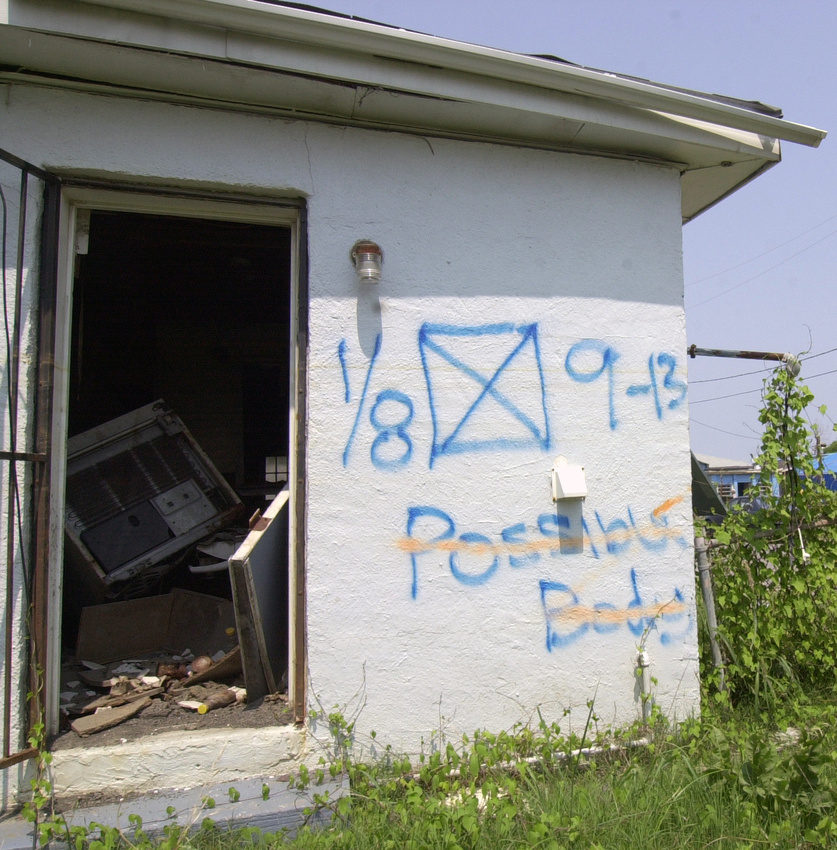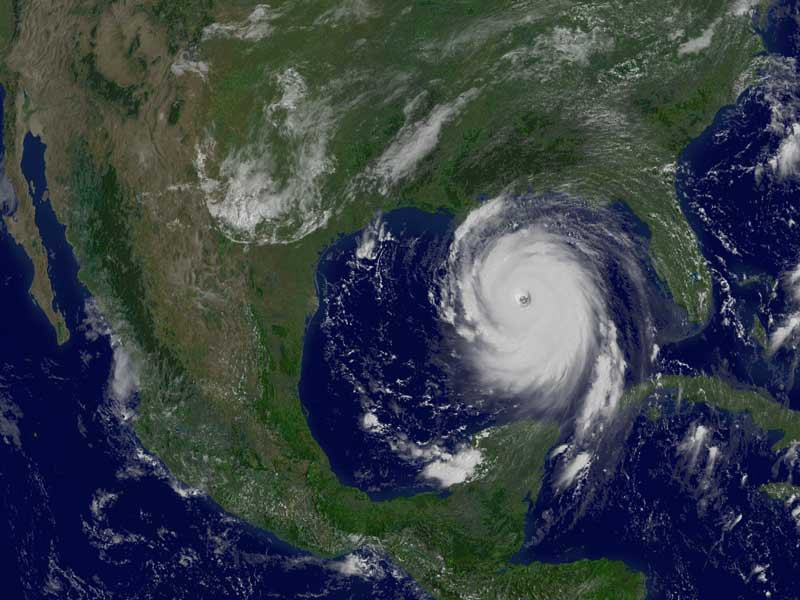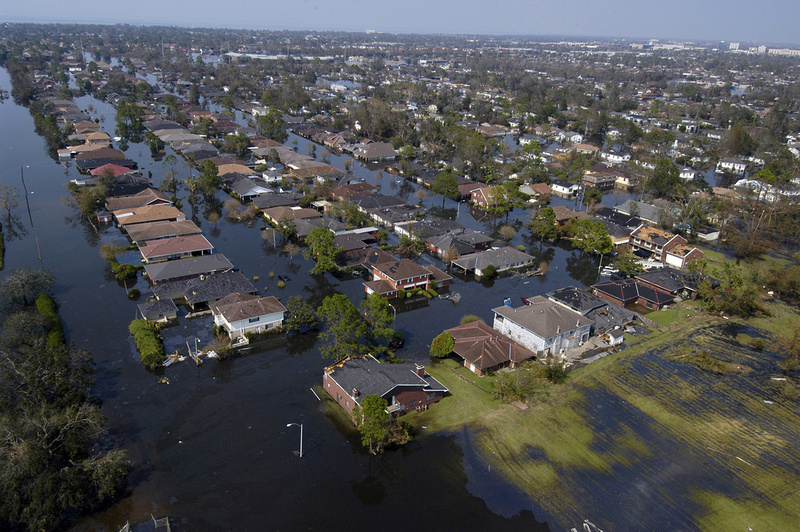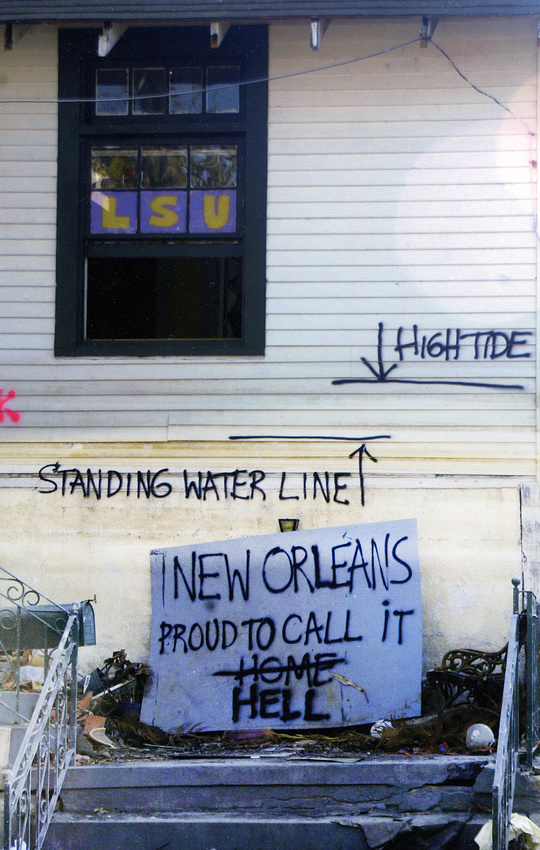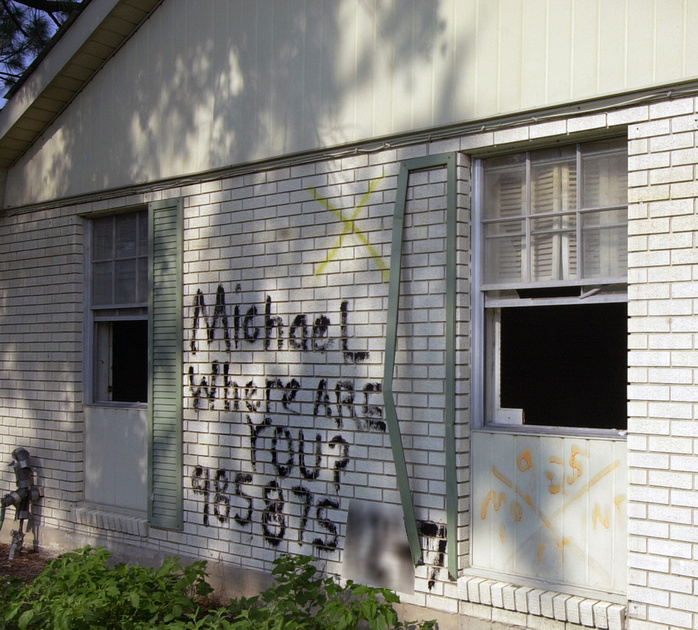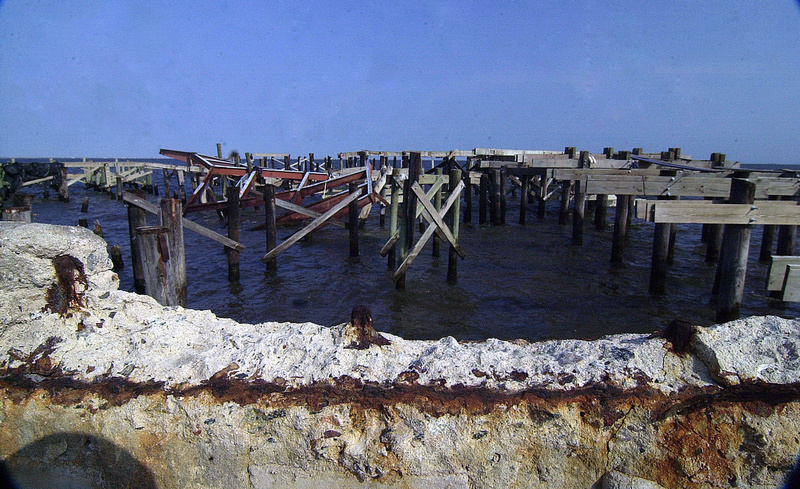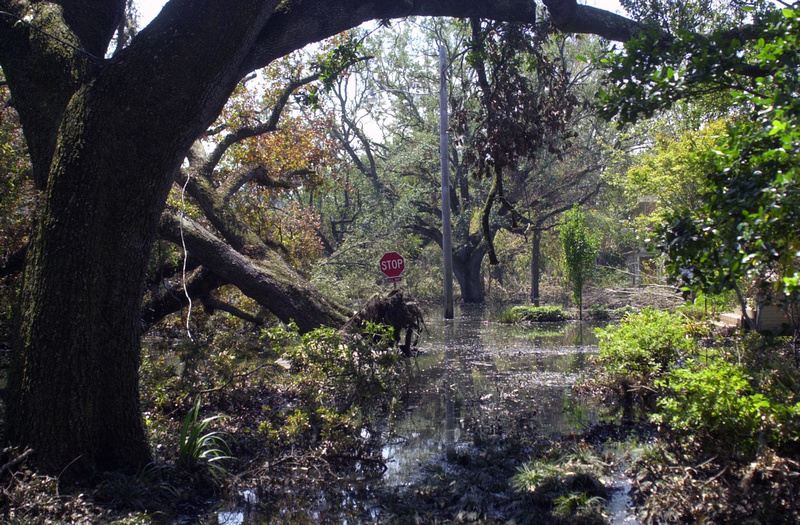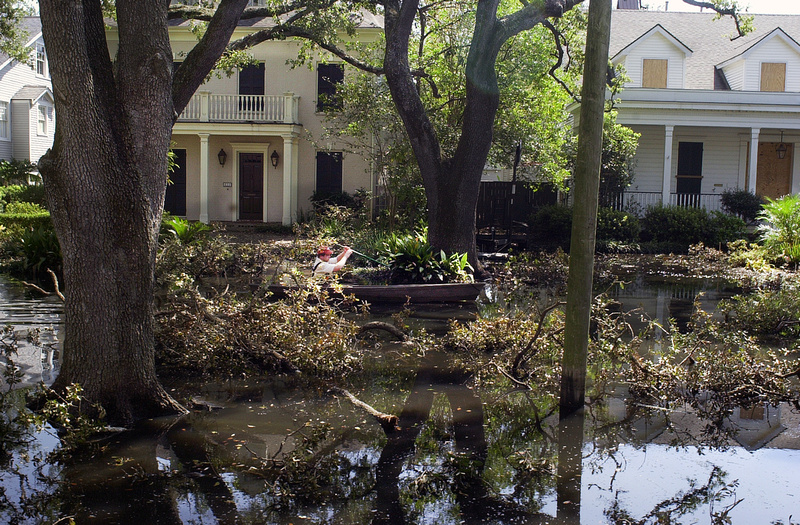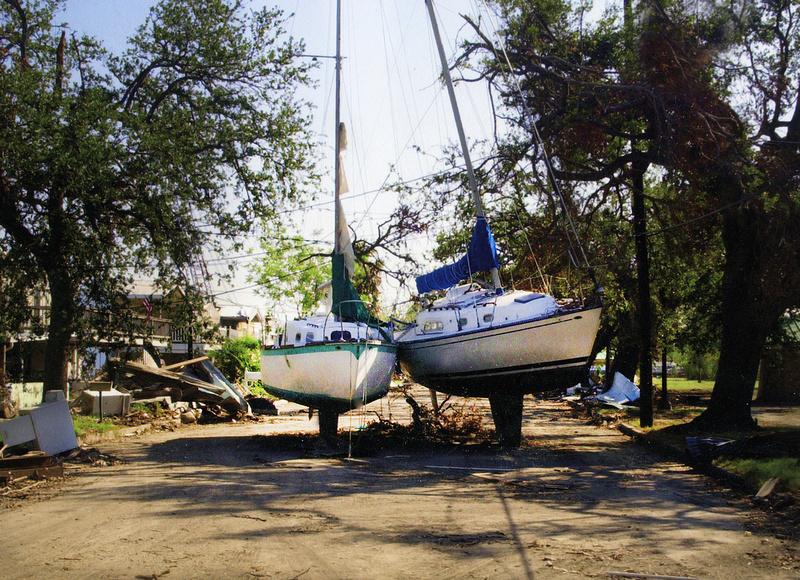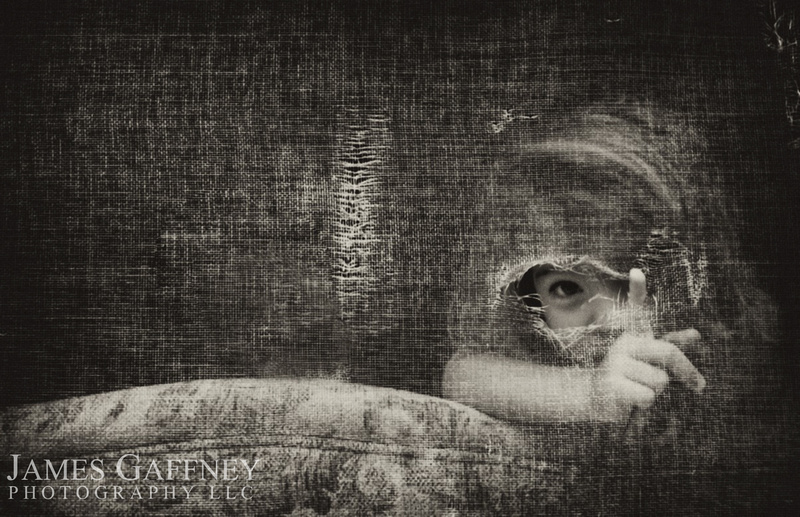TEN YEARS AGO: Hurricane Katrina Proved a Moveable Feast of Hell on Earth
NO MATTER WHAT CALAMITIES THROUGHOUT HISTORY have befallen this mysterious Creole child of the moonlit swamp, from hurricanes and yellow fever epidemics to citywide conflagrations, New Orleans has always landed on its feet. One way or another. But 10 years ago we had our doubts as we took stock of the aftermath of Katrina, a Category 5 hurricane, which had weakened to a 3 by the time it hit New Orleans on Aug. 29, 2005. The storm would go down as one of the five deadliest and most costly hurricanes in U.S. history due to the catastrophic flooding that occurred over 80 percent of the metropolitan area when the city’s levees breached, collapsed or were overtopped. An estimated 1,836 people would lose their lives.
When I awakened early on the morning of Aug. 28, my wife Cathy was standing in the living room in front of the TV watching the now round-the-clock coverage of Hurricane Katrina on local stations. "This is bad," she said matter of factly. "We have to evacuate." Hours later after packing our car with essentials for what we thought would be at best a two-day evacuation, we joined other New Orleanians in worm-inching bumper-to-bumper evacuation traffic, an anxiety-ridden, moveable feast of despair. Our destination was Opelousas, La., population 16,000, a city 135 miles northwest of New Orleans, which would put us sufficiently out of harm’s way. The normally two-hour drive took 10 hours.
We spent the first few days and nights mostly sitting on the couch in Cathy's brother's house biting our nails or crying as we watched news reports showing the unprecedented flooding occurring throughout New Orleans and the utter destruction of parts of the city including the Lower Ninth Ward and neighboring St. Bernard Parish. Friends and other New Orleans family meantime had evacuated to other parts of the country. We kept in touch constantly as best we could in lieu of spotty cell phone coverage. All I knew for certain was this: My little sweet-pea life as I had lived it with my wife had evaporated overnight -- poof. I began remembering all of the horrid stories my parents had told me as a youth about the grinding poverty and breadlines of the Great Depression and the entirely different kind of horrors that followed during World War II. I realized for the first time that they weren't so much bragging about their hardships as they were preparing me for that day in life when the s**t totally hits the fan. And when it does you can and will survive by putting one foot in front of the other because you quite simply have no other choice. Stories and images of rampant looting as well as the dire conditions at the Superdome and New Orleans Convention Center for thousands of people who had evacuated to these venues before the storm hit would become the more nightmarish memories of the days that immediately followed Aug. 29. Equally nightmarish if not wholly surreal were aerial images revealing the sheer magnitude of to-the-roofline flooding throughout the metropolitan New Orleans area that remained days and weeks after Hurricane Katrina.
Soon but not soon enough for the majority of residents the National Guard was deployed to New Orleans to restore order, provide emergency relief and conduct door-to-door search-and-rescue operations. Before long – and for the first time in U.S. history – a major American city was under a mandatory evacuation. The metropolitan-wide population of nearly 1.5 million people was ordered to leave until the flooding had receded, many with little more than the clothes on their backs. Compared to them we were living large. For nearly six weeks we lived in a 30-foot Prowler trailer (loaned to us from a generous Opelousas couple who had heard of our plight) in the driveway of the home of my wife’s niece Claire and her husband Larry. Cathy’s brother Francis and his wife Sandie lived directly across the street. Within days Larry had rigged our new abode with cable and Internet. Claire and Larry made us part of their family (which included their three children) and soon we began finding our terra firma amid trips to local Red Cross locations to sign up for disaster relief.
Meantime we didn’t know if we had jobs or a home – hell, even a city to return to. Yet in some strange way life seemed good. Really good. Days and nights were suddenly uncomplicated. Wake up. Drink coffee with my brother-in-law Francis. Watch the news. Eat lunch. Do stuff. Buy cheap shirts at Walmart (after all we weren’t going home any time soon). Hug the kids when they got home from school. Fix dinner. Watch the news. Because crazy circumstances often lead to crazy thinking, I began to contemplate the future: writing a new guidebook – something Cathy and I would do together as we embarked upon our post-apocalyptic, post-Katrina life on the road. The working title was "America Da’ Beautiful: 100 National Parks You Simply Must Visit After Your City Has Been Destroyed." Or something like that. Like I said, my mind was as warped as a Uri Geller spoon though I didn’t realize it at the time. We volunteered at a local Opelousas church that had taken in nearly 100 New Orleanians and their families during the mandatory evacuation. "What do you need done that isn’t getting done?" I asked the Sister who was staffing the check-in desk. She pointed to the pile of overstuffed black lawn bags piled up in the corner. "We need clothes washed – every day," she said. So began our morning ritual of swinging by the church to pick up bags of clothes before heading to local washerteria. Funny what you learn about families you’ve never met when you wash and dry their clothes – particularly when you’re folding the mechanic’s blue jumpsuit, the nurse’s green scrubs and a small child’s Star Wars T-shirt before neatly arranging the garments back inside the large black lawn bags, just so they’ll know that someone they’ve likewise never met actually gave a damn. When the washerteria manager caught wind from regulars about the out-of-town couple arriving daily to wash large amounts of clothes, he would discretely leave a roll of quarters for us atop the extra-large dryers we used, even though we never once met the guy or had the chance to thank him. Those mornings helped us keep our sanity. Meantime we bonded with our Opelousas relations in ways we never thought possible. My wife and I grew closer to their three children -- Jacob, Laurel and Tyler -- who seemed to delight in having their aunt and uncle living in a trailer in their driveway. We cooked and enjoyed dinners together and generally tried to make ourselves as useful as possible while watching and waiting along with tens of thousands of other New Orleanians, many of whom had been evacuated to cities far, far from home. Some of them wound up never coming back. RETURNING HOME TO NEW ORLEANS FOUND US DRIVING THROUGH A MAJOR U.S. CITY at night in total darkness thanks to the complete absense of streetlights (or any lights for that matter), this due to the fact New Orleans' electrical power grid had been destroyed. Nothing was open save for two small grocery stores and a trio of restaurants. When our neighborhood grocer finally reopened we celebrated those rare days when it stocked both milk and bread. On the day it permanently extended store hours to 6 p.m., we thought about holding a celebration in the parking lot. Too soon.
Restaurants coming back on the grid became nighttime gathering places to eat (since many residents still didn’t have electricity or gas), swap war stories, inquire as to the safety and well-being of family members, and catch up on post-Katrina news as filtered through the emotionally devastated hearts of people whose love for this city is unlike anything I have ever known. "All of the West End restaurants are gone," an elderly man said softly, referring to a popular New Orleans neighborhood and long-time dining destination, tucked on the southern lip of Lake Pontchartrain. "The Lighthouse and Southern Yacht Club -- gone, too."
Because the metropolitan area had been off the grid for weeks, the lack of electricity in summertime New Orleans homes had turned refrigerators into putrid tombs of rotted food. To open one without a protective odor mask was to do so at your own peril. It still makes me gag to remember how the supermarket-sealed quartet of formerly frozen Cornish game hens in my freezer had so decomposed that they felt like water balloons when I picked them up – that is, before the seal burst causing the fetid juices and disintegrated meat to cover my bare hands. I shrieked like a drag queen and then summarily puked into my mask. Unfortunately Larry Dejean, who had come to help us this day, was an eyewitness, which is why I’m fessing up about this event and thus taking control of the narrative.
Surrealism was everywhere. But no more than the strange sight of a city whose curbs were lined with discarded refrigerators rendered unusable because of the smell. Since trash pickup was spotty and took days or even weeks at best, the ubiquitous refrigerators became not only a citywide fixture but also a weird sort of curb art which people adorned with spray-painted humor: "Free Gumbo Inside!" "Wife Inside – Don’t Open." "Lunch for Orleans Levee Board." You get the picture. Stranger still was the new soundtrack being created by the whirring motor blades of ubiquitous military helicopters flying overhead in a city otherwise eerily silent due to the lack of running air conditioners and car traffic. Among the first residents on our street to return home, we watched one afternoon as a Chinook helicopter hovered directly over our house, a person in military uniform sitting in the open bay door with a pair of binoculars watching to make sure we weren't looters. We waved. They waved. This was The New New.
Our dear friend Judy, who had lost her Gentilly home to Katrina flooding, moved back from her evacuation digs in Arkansas and into our garage apartment, where she lived for a year as the three of us returned to work and began in tandem with our city the slow process of healing and recovery. Our new little family was a sort of post-Katrina version of the Three Musketeers. My sister’s husband Michael, a construction tradesman in San Clemente, Calif., spent a week with us repairing damage to our home. This despite the fact our underground sewage lines had ruptured forcing all of us – Michael, Cathy, Judy and me – to temporarily "evacuate" anew to a friend’s house. As evidence of the country’s outpouring of sympathy for New Orleans and its beleaguered residents, Michael’s then-employer, a San Clemente hospital, not only gave him time off of work but the staff also bought him a round-trip plane ticket as well as gift cards from Big Box hardware stores to use when he arrived in the Big Easy. We took Michael for a post-Katrina tour that stretched from New Orleans’ virtually flattened Lower Ninth Ward south to what little remained of the tiny fishing village of Shell Beach in lower St. Bernard Parish. So many people lost so much. Nothing was a pretty sight. "Is that really a recliner up in that tree?" Michael asked in disbelief, as we snaked along the two-lane blacktop that twisted through Shell Beach. Later that evening we found ourselves at Pat O’ Brien’s huddled under an outdoor cocktail-table umbrella, which was barely sheltering us from the rain, drinking the tourist-popular bar’s rum-fueled Category 5 drink. Nothing including alcohol seemed to quiet our memories of what we had witnessed earlier that day. Ten years after, the City That Care Forgot has recovered and rebounded to a greater or lesser degree than probably anyone had a right to expect. Certainly more work remains to be done. But, speaking only for myself, the legacy of the near-apocalyptic event known as Hurricane Katrina has been a renewed appreciation that New Orleans, warts and all, will always be a city whose heart beats in time with the angels. Amen.
Keywords:
Category 5,
Hurricane Katrina,
Louisiana,
New Orleans,
Opelousas,
St. Landry Parish,
evacuation,
hurricane
Comments
Jeff(non-registered)
great photos...love your work!
Jeff http://www.printradiant.com | http://www.printlinkage.com | http://www.hitsticker.com | http://www.stickermac.com
ts'no ruob(non-registered)
wow the title of the photo of your niece... genius
No comments posted.
Loading...
|

